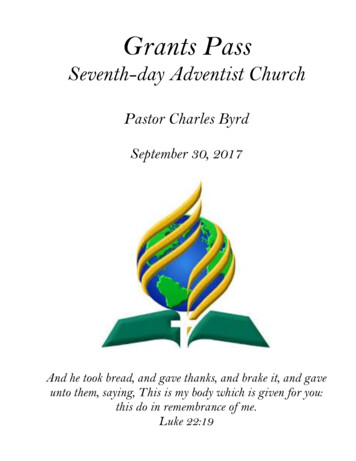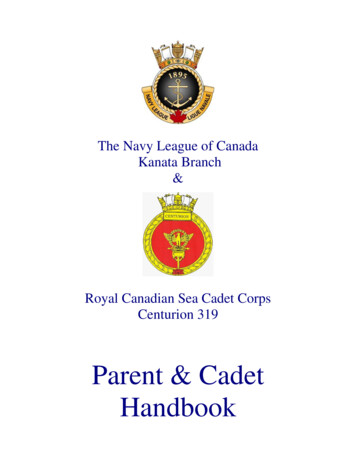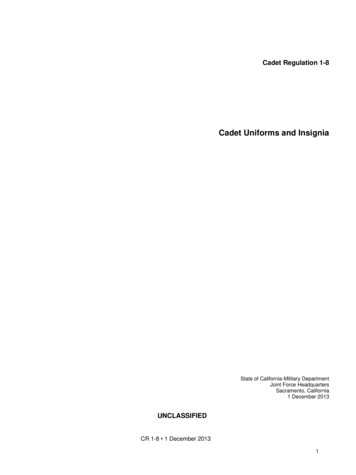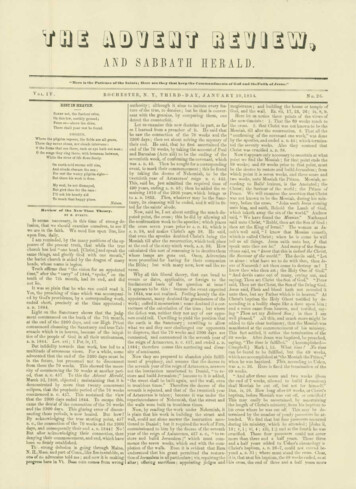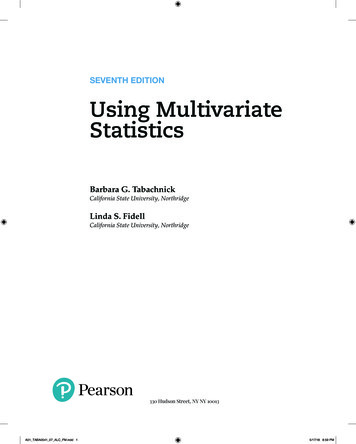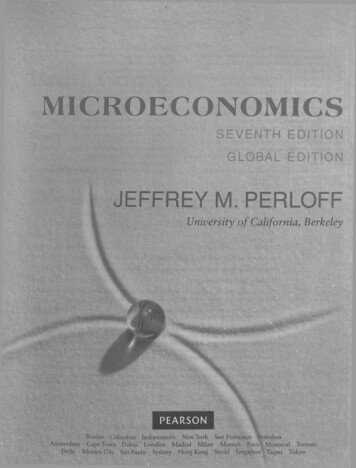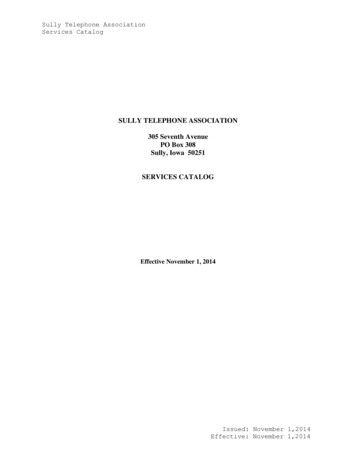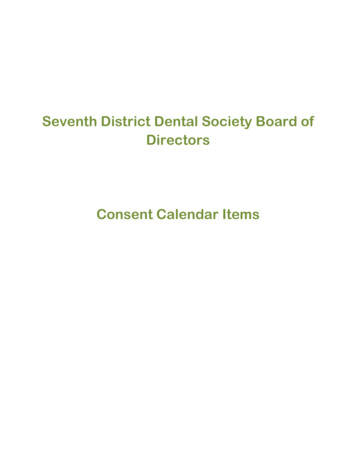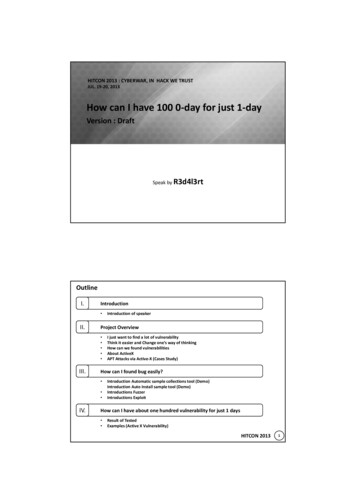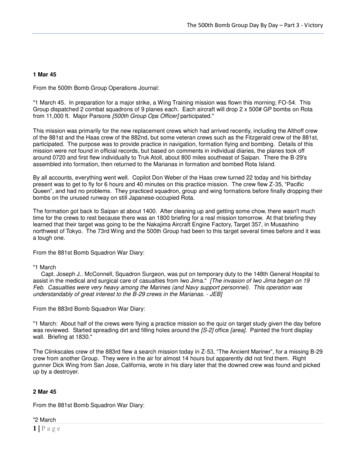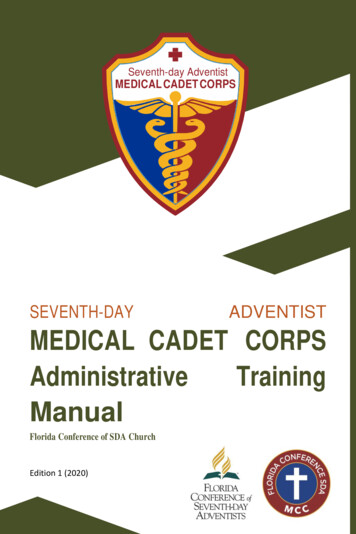
Transcription
Seventh-day AdventistMEDICAL CADET CORPSSEVENTH-DAYADVENTISTMEDICAL CADET CORPSAdministrativeTrainingManualFlorida Conference of SDA ChurchEdition 1 (2020)1
2ContentsPREFACE TO THE FIRST EDITION . 3PHILOSOPHY . 4Objectives. 4Objective Implementation . 5Membership Requirements . 7Training . 8Drill & Ceremonies . 8Rank and Promotion Program. 9Code of Conduct. 10Discipline . 12SYSTEM OF MERITS (AWARDS & DECORATIONS) . 12Uniforms . 12Physical Fitness . 12NIMS Compliance and Community Emergency Response Team Training . 13
3PREFACE TO THE FIRST EDITIONMessage from the Florida Conference CommanderThis Administrative Training Manual is not to intended to be a single sourcesolution to provide subordinate commanders within The Florida ConferenceBrigade of the Medical Cadet Corps with everything they need to train and leadtheir units successfully, Rather, it is to be an opportunity to direct the members ofthe Florida Conference Medical Cadet Corps to the resources that the y may need,while providing the leadership guidance specific within the Florida ConferenceMedical Cadet Corps, in how to employ these resources in a manner consistentwith loving character of our Lord Jesus Christ.We in the Florida Conference are familiar with the consequences of disaster, livingon a peninsula often buffeted with the effects of tropical storms and hurricanes. Tobe able to safely respond to the needs of our community and fellow Floridians intimes of disaster is the primary purpose for which the Florida Conference MedicalCadet Corps Brigade is organized.Ellen G. White, in An Appeal for the Medical Missionary College, (pp. 14, 15) stated“Do medical Missionary work. Thus you will gain access to the hearts of the people.The way will be prepared for more dedicated proclamation of the truth. You willfind that relieving their physical suffering gives the opportunity to minister to theirspiritual needs.Let us pray that this program will grow into a shining light upon a hill that will attractmany to an eternal saving relationship with our Lord, Jesus.Pastor Pedro Perez, Brigadier GeneralCommander, Medical Cadet Corps BrigadeFlorida Conference of the Seventh-DayAdventist Church
4PHILOSOPHYThe World Service Organization/National Service Organization(WSO / NSO) administers the Medical Cadet Corps (MCC).Membership is open to all Seventh-day Adventist Churchmembers who are at least 18 years of age and older. Members aretrained and equipped to serve God and the community, and toprovide aid during natural disasters or accidents.Originally organized to prepare young men to serve in the militaryas medical providers, the focus in the Florida Conference is toequip an Army of young people, rightly trained, to serve theircommunities and be equipped to share the Gospel of JesusChrist.ObjectivesA. Since the MCC’s recognize our worlds growing needs, which are aresult of disasters, tornados, fires, war, illnesses, accident, hunger andother reasons; we believe it to be our duty and privilege to give oursupport in the local churches, neighborhoods, cities and even anunknown person who is in need.B. We are part of an organized church, which believes that those that aresuffering are our neighbors. When we recognize a need, it becomes ourduty to help, because our calling is based on the parable of the “GoodSamaritan”.C. We believe that through our actions it is possible to better show the loveof God to those that we serve. To serve the needs of others is our maingoal, by doing this, our Lord, Jesus Christ, will be known through theentire world
5Objective ImplementationLTC Cyril B. Courville, (Medical Corps, Reserve) wrote in theintroduction of the Medical Cadet Corps Training Manual,(Courville & Gilbert, 1943) “The training program itself was notoriginal with the Medical Cadet Corps. It was adopted, lock, stock,and barrel from the Medical Department of the United StatesArmy”. Seventy Seven years later, as the Florida Conferenceprepares the revitalize the Medical Cadet Corps for the twenty firstCentury, it is not the United States Army that our Cadets arepreparing to serve with, but the myriad of Local, State, andFederal partners who make up any large scale emergency and/ordisaster response. Fortunately, as was the case 77 years ago,there are already established training programs, to allow theMedical Cadet Corps to become integrated into the greatercommunity of emergency responders, in much the same mannerthat allowed the Los Angeles Cadets trained in 1936 to integrateinto the military response of our country after the attack on Pearlharbor in 1941.As a consequence of the Federal response to the Events ofSeptember 11th, 2001 and the escalating war on terror, PresidentGeorge H. W. Bush, on February 28, 2003, 41st president of theUnited States issued Homeland Security Presidential Directive-5(HSPD-5). Simply stated, HSPD-5 stated “To prevent, preparefor, respond to, and recover from terrorist attacks, majordisasters, and other emergencies, the United States Governmentshall establish a single, comprehensive approach to domesticincident management .to enhance the ability of the UnitedStates to manage domestic incidents by establishing a single,comprehensive National Incident Management System (NIMS).”As a aspiring member of the responder community, it is incumbentupon the Medical Cadet Corps to be familiar with, proficient in andorganized under the precepts of NIMS to allow our Cadets to
6function effectively within this environment.The National Incident Management System, and its integratedIncident Command System, in no way mandates theorganizational structure of the Medical Cadet Corps. The MilitaryDNA of the Cadet Corps and historical heritage of ourorganization is not without value. What NIMS does however, isto demonstrate the manner in which our cadets may be deployedwithin a larger multi-jurisdictional response and provide us withthe tools to be effective partners with all of the other engagedstakeholders.The Community Emergency Response Team (CERT) programstarted in Los Angeles, California before making its journeyacross the United States and abroad. Officials from LA traveledto Japan in February of 1985 to study its disaster response plans.The team discovered that Japan had extensive training programsthat were neighborhood-based, focusing on fire suppression, lightsearch and rescue operations, first aid, or evacuation. The LAgroup traveled to Mexico City following a magnitude 8.1earthquake that killed more than 10,000 people. Although ers conducted light search and rescue operations. Thevolunteers were credited with saving over 800 people, but over100 volunteers died in the effort.Having determined that pre-disaster training was a valuableresource for the city, officials began training leaders ofneighborhood watches to perform basic fire suppression, lightsearch and rescue, and first aid; while ensuring the safety of thevolunteer responders. This first team of 30 people completedtraining in early 1986 and proved that the concept wasviable through various drills, demonstrations, and exercises.
7In 1993, The Federal Emergency Management Agency (FEMA)decided to make the concept and program available tocommunities nationwide. The Emergency ManagementInstitute (EMI), in cooperation with the LAFD, expanded the CERTmaterials to make them applicable to all hazards.The Command Structure of the Florida Conference Medical CadetBrigade has determined that as the Brigade grows, it shall utilizebe NIMS compliant in its activities and utilize the training contentavailable from the Federal Emergency Management Agency(FEMA) to train our units as qualified CERT teams.Membership RequirementsA person who initially joins in the Medical Cadets as a recruit doesnot carry any rank. Below are detailed steps to begin in thisministry as a Medical Cadet, but more details can be found on thedocument How to Become a FL Conf. MCC Member as found onthe FL Conf. MCC website on the “Join MCC” tile:1. Pray About Joining2. Be at least 18 years old3. “Contact Us” at the FL Conf. MCC Web Page to acquire theFL Conf. MCC Membership Application Package4. Complete the Adventist Screening Verification (ASV)5. Obtain a FEMA Student ID (FEMA SID)6. Submit the FL Conf. MCC Membership ApplicationPackage7. Attend local MCC Unit meetings ( 2 meetings per month)8. Begin Independent Individual Study trainings
8TrainingTraining is intended to build unit cohesiveness and provide thebasic content needed to equip the team to perform as a ministerialoutreach to their community in times of disaster. Detailed trainingcirculars are under development and will be available through theFlorida Conference MCC Brigade Command; therefor thisparagraph is intended to only provide a general overview of thecontent to be provided.Operating the Florida Conference MCC under a threefold principleof education; that being Mind, Body and Spirit, the contentdelivered to cadets, under the program can be thus divided. Mind: Educational content will be delivered to enhance theintellectual understanding the Cadet will develop ofdisaster response (NIMS, CERT, Psychological First Aid,ETC.) Body: Physical Fitness, Kinesthetic drills, and marchingwill be utilized to develop body memory of set tasks andensure the Cadet is fit to perform them. Spirit: The Florida Conference Medical Cadet CorpsBrigade seek to ensure that each Cadet is equipped to beable to express what they believe as a Seventh-dayAdventist, why they believe it, and lead others to a savingrelationship with our Lord and Savior, Jesus Christ.Drill & CeremoniesAs an entity, the Medical Cadets ministry has ceremonies whichmay contain great meaning and value. The use of Drill andCeremonies to develop unit cohesion and allow a leader to movetheir team effectively with a minimum of effort or discussion is of
9inestimable value, especially when operating under austere andstressful conditions. However, it must be remembered that Drilland Ceremonies are a tool to develop the Unit, rather than theUnit ever becoming a tool to perform the Ceremony.We serve a Loving Savior who seeks honor through service,rather than extravagant performances.Some ceremonies included in the Florida Conference MCCProgram may include:Presentation of AwardsChange of CommandRetirement of MCC officersParades, Inspection, and passing in reviewSpecial RecognitionsThe Florida Conference Medical Cadet Corps Brigade follows theArmy Drill and Ceremonies Manual (currently TC 3-21.5,historically FM22-5). A special Training Circular outlining how theManual shall be utilized within the Brigade will be developed addistributed through the command.Rank and Promotion ProgramRank and Promotion within the Florida Conference Medical CadetCorps Brigade is utilized to recognize engagement of themembers as well as leadership potential and commitment to thevalues of the program.One of the key elements of the Incident Command System (ICS)under NIMS is that the Chain of command, refers to the orderlyline of authority within the ranks of the incident managementorganization; while, unity of command means that every individualhas one, anon only one designated supervisor to report to; it is aclear Chain of Command.
10Rank within the Florida Conference Medical Cadet Corps Brigadeis assigned by position the Brigade Headquarters. AlthoughMedical Cadet members may have received rank designationsfrom other agencies, within the Florida Conference, the Chain ofCommand, and inherent delegation of authority, demands thatonly Officers (Commissioned, Warrant, and Non-commissioned)designated by the command structure of the Florida ConferenceMCC Brigade shall have Command/leadership authority within theBrigade.Detailed instructions on position and rank assignments as well aspromotions will be included in the training circular on rank andpromotions.Code of ConductThe Code of Conduct is a public declaration of the manner inwhich all members of the Florida Conference Medical CadetCorps Brigade will conduct themselves at all times (not only whenengaged in Medical Cadet Corps activities) If a person cannotcommit to these shared values, they may not become a memberof the Florida Conference Cadet Corps Brigade. They arewelcome to fellowship and train with the local MCC unit, but theyare not eligible to deploy or hold any position of rank or authority.
11Code of Conduct1. Recognizing that I must possess and maintain a healthy bodyin sound mind, I will refrain from using all those substances thatharm my health such as controlled substances, hallucinogens,cigarettes, and all kinds of drugs.2. I am committed to be trained in a high-quality program thatincludes the harmonies development physical, mental andspiritual capacities; therefore I will obey the rules, commands andorders of the officers in my chain of command, providing they arenot in conflict with any greater moral standard believed by thedoctrines of the Seventh-day Adventist Church.3. I understand that the resources provided to me, and those ofour group are a gift of God, and we are only custodians. I willmake cheerful contributions, as I am able and called, and seek tocare for those things entrusted to me while awaiting the Savior’sreturn.4. Because I wear a Uniform, I am a visible representation of thecharacter of the Medical Cadet Corps, and the Master, JesusChrist. Therefore, I will not go to places or do things that areinappropriate while wearing my uniform and will strive to presentmyself in a well-groomed appearance, and seek to ensure myuniform is in compliance with the directions and guidance of mycommand.5. I understand that as part of the body of Christ, each of us hasa contribution to make. Therefore, I will work to be engaged in allof my MCC unit activities, and provide a just reason for myabsences.6. I will not use profane, vulgar, or obscene language at any time.7. I will assist responsibly and respectfully, to the best of my abilityand understanding, in the ministerial and outreach activities bymy Medical Cadet Corp staff.
12DisciplineDiscipline is necessary whenever working in the Lord’s work. Weare called to die to self and allow the Lord to work within us. Whenbehavior needs correction, discipline should be of a redemptive,rather than a punitive nature. Cadet should never be publiclyhumiliated or embarrassed. Groups should never be punished forthe acts of individuals. Most importantly, the character of Christneeds to be magnified, often through dedicated prayer, in all actsof discipline.SYSTEM OF MERITS (AWARDS &DECORATIONS)The system of merits is determined by the General Conference ofSeventh-day Adventists, and Higher Headquarters. Proceduresfor the awarding of merits are provided in the Training circulardedicated to that function.UniformsThe Authorization of Uniforms is determined by the GeneralConference of Seventh-day Adventists, and Higher Headquarters.Procedures for the proper wearing of the Uniform are provided inthe Florida Conference MCC Field Deployment & Uniform Manual(2020) dedicated to that function.Physical FitnessThe Florida Conference Medical Cadet Corps Brigade follows theArmy Physical Readiness Training Manual (FM7-22, dated
13October 2012). As stated earlier, physical fitness training is usedto develop unit cohesiveness and capability, it should never beused to embarrass a cadet for their lack of ability, but always usedto encourage individuals to strive for a healthier lifestyle.NIMS Compliance and CommunityEmergency Response Team TrainingNIMS compliance requires all responders share a commonoperating picture and are able to communicate to each othereffectively. FEMA had developed online training classes thatprovide the foundation of that training. To begin, each cadet mustregister with FEMA to be assigned a Student IdentificationNumber (SID). This FEMA SID will be used be the FloridaConference Medical Cadet Corps Brigade to identify the cadetscredentials file as well.Register for a FEMA ID here: https://cdp.dhs.gov/femasid/registerThe initial three classes that each cadet must take are:IS-100.C: Introduction to the Incident Command System, ICS x?code IS-100.cIS-200 C: Basic Incident Command System for Initial w.aspx?code IS-200.cIS-700.B: An Introduction to the National Incident Management aspx?code IS-700.bAs a background and prerequisite for CERT training, FEMA offersthe following online Course:IS 317: Introduction to Community Emergency Response aspx?code IS-317
14It takes between six and eight hours to complete the course.Those who successfully finish it will receive a certificate ofcompletion. It has six modules with topics that include: Introduction to CERTFire SafetyHazardous Material and Terrorist IncidentsDisaster Medical OperationsLight Search & RescueThe Community Emergency Response Team (CERT) programeducates volunteers about disaster preparedness for the hazardsthat may impact their area and trains them in basic disasterresponse skills, such as fire safety, light search and rescue, teamorganization, and disaster medical operations. CERT offers aconsistent, nationwide approach to volunteer training andorganization that professional responders can rely on duringdisaster situations, which allows them to focus on more complextasks. Through CERT, the capabilities to prepare for, respond toand recover from disasters is built and enhanced.The CERT Basic Course is delivered in the community by a teamof first responders, and other qualified volunteers. Theorganization and timing of training and meeting varies fromprogram to program. It is often broken up into two to four hourblocks over a series of evenings or weekends. Disaster Preparedness: Addresses hazards specific to thecommunity. Materials cover actions that participants andtheir families take before, during and after a disaster as wellas an overview of CERT and local laws governingvolunteers.Fire Suppression: Covers fire chemistry, hazardousmaterials, fire hazards and fire suppression strategies.However, the thrust of this session is the safe use of fireextinguishers, controlling utilities and extinguishing a small
15 fire.Medical Operations Part I: Participants practice diagnosingand treating airway obstruction, bleeding and shock byusing simple triage and rapid treatment techniques.Medical Operations Part II: Covers evaluating patients bydoing a head to toe assessment, establishing a medicaltreatment area and performing basic first aid.Light Search and Rescue Operations: Participants learnabout search and rescue planning, size-up, searchtechniques,
incident management .to enhance the ability of the United States to manage domestic incidents by establishing a single, comprehensive National Incident Management System (NIMS).” As a aspiring memb
